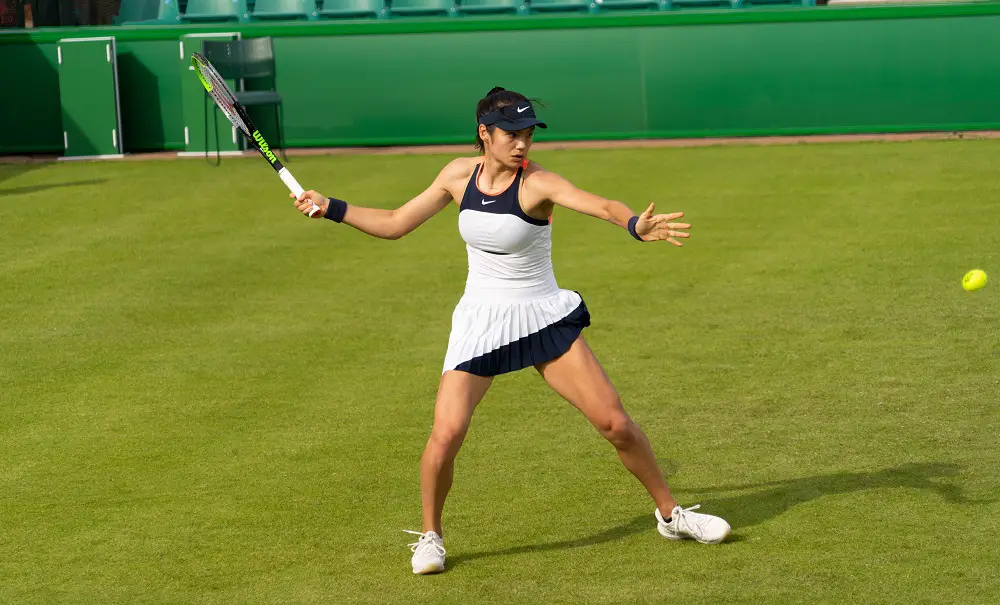In this article we go in depth in the Grand Slam tennis qualification.
The four Grand Slam tournaments – the Wimbledon Championships, the U.S. Open, the French Open and the Australian Open — are the pinnacle of professional tennis. A small fraction of tennis players ever get the chance to play in these events.
How does the qualification process work? What requirements must players meet to earn a spot? Let’s go through all of the ways a tennis player can qualify for a Grand Slam.
Table of Content
Three Ways to Qualify for Grand Slams
All four Grand Slams welcome 256 players every year in the singles draw. Add a few more doubles teams in the men’s, women’s and mixed draws and there are more than 500 players who take to court there.
The men’s and women’s competitions have the same number of players — 128 singles players and 64 doubles teams. 32 mixed doubles teams also compete in their own tournament to bring the men’s and women’s events closer together.
The International Tennis Federation (ITF), Association of Tennis Professionals (ATP) and Women’s Tennis Association (WTA) fill up these 128 spots in three different ways:
- The top 104 players in the world who sign up for the tournament automatically qualify.
- An additional 16 players earn a spot by winning three rounds in a qualifying tournament against lower-ranked professionals.
- The final eight players earn wildcard spots.
This aforementioned numbers system is an indicative list with a few exceptions here and there.
For example, the ladies’ competition at Wimbledon automatically invites the top 108 players instead of the top 104. There are still eight wildcard spots available, which means only 14 players can earn their place through a qualifying tournament instead of 16.
Originally, Grand Slams were exclusive tournaments that only consisted of professionals from their own countries. Amateurs and international players were not allowed for much of the early 20th century due to global conflicts and travel limitations, among other factors.
The first Wimbledon in 1877 had just 22 participants, all of whom were local Englishmen.
Today, the selection process is much more egalitarian and merit-based — with the exception of some wild card spots, which we’ll discuss later. International players started getting more representation as travel became easier.
The “Open Era” of Grand Slams officially began in 1968 when the tournaments started accepting amateur players.
The selection process seems straightforward on the surface, but earning a world ranking from the ITF and becoming eligible for the tournament is extremely difficult. Let’s take a deeper dive into the three ways that people qualify for Grand Slams.
Also Read:
- Why do Tennis Fans Share a Love-Hate Relationship with Pickleball?
- Advantages of Properly-Maintained Tennis Courts
How World Rankings Affect Grand Slam Qualification
The men’s world tennis rankings and women’s world tennis rankings determine a vast majority of the Grand Slam participants. These rankings are based on a point system that rewards players for performing well in other professional tournaments.
Everyone who falls within the top 104 automatically qualifies for the four Grand Slam tournaments.
However, there are exceptions. If a player in the top 104 has to withdraw from a Grand Slam for any reason, the 105th-ranked player will take their place. The first 104 spots in the tournament are always filled by the world’s best available players.
Players get injured before Grand Slams all the time, so the ITF allows them to apply for protected rankings. A protected ranking grants a six-month leave for recovery and allows the players to use their pre-injury rankings to qualify for the next Grand Slam.
Injuries are the main causes that prevent players from participating in Grand Slams. If an otherwise direct qualifying participant suffers an untimely injury, the “lucky loser” rule comes into play.
A player who was previously eliminated from the qualifiers can take the injured player’s place. This is applicable across all tennis tournaments, not just Grand Slams.
For example, Russian men’s player Andrey Rublev got a last-minute invitation to the 2017 Croatia Open as a lucky loser. He went on to win the tournament despite not originally qualifying. However, a lucky loser has never gone on to win a Grand Slam.
Sometimes players withdraw for other reasons.
For example, players have opted out of Wimbledon in the past because it still uses traditional grass courts, while the other three Grand Slams use a clay or hard court surface. Grass courts promote a fast and erratic pace of play because of the smooth and uneven surface.
There are players who have previously not been allowed to participate in Grand Slams too; like was the case with Novak Djokovic because of his vaccination status and with Russian and Belarusian players at Wimbledon.
Qualifying Tournament
After the world’s best players fill the top 104 spots, the players ranked from 105-232 compete in the qualifying tournament. This competition is meant for the players who just missed the cut.
Men’s qualifiers have 128 players, while women’s qualifiers have 96 players. Only the top 16 earn a spot in the Grand Slam. That means you have to win at least the first three matches.
Winning a Grand Slam after competing in a qualifying tournament is extremely rare. One of the most recent players to accomplish this feat was British prodigy Emma Raducanu.
At just 18 years old, she won the 2021 Women’s U.S. Open after playing a grueling ten matches of tennis — three matches in the qualifier and seven more in the Grand Slam itself.
Raducanu’s victory is especially impressive because the tennis courts for the U.S. Open experienced flood damage early in the tournament.
Adverse weather conditions significantly affect tennis rackets and impede the players’ movements. Her historic performance inspires other players in the qualifying rounds.
As mentioned earlier, the “lucky loser” rule also applies to qualifying tournaments. If the winner of the tournament withdraws due to injury, illness or other circumstances, the runner-up will take the winner’s place.
Grand Slams always ensure that the tournament fields are filled with the most elite competition possible.
Also Read:
- Everything You Wanted to Know About Tennis Racket Stringing Machines
- Best Tennis Racket Stringing Machines to Buy This Year
Doubles and Mixed Doubles Qualification at Grand Slams
There is usually no qualifying tournament for doubles tennis. In doubles, 64 pairings make it to the Grand Slam.
The top 57 doubles teams in the world earn an automatic bid, while seven more pairings can earn their spots based on rankings. Doubles players can even use their individual rankings to improve their chances of making a Grand Slam.
The same format applies to mixed doubles. Since there aren’t many consistent mixed doubles teams, individual rankings and past performances primarily determine which doubles teams get to play in the Grand Slam.
Most of the 57 automatic bids go to doubles that play together often, such as the “Special Ks” pair of Nick Kyrgios and Thanasi Kokkinakis.
The longer a duo plays together, the more success they tend to have. Players who don’t usually play doubles simply ask around the tennis world until they find a partner.
If two top-104 professionals decide to play in the doubles tournament, they will automatically get a spot. However, if one or both of them are unranked, they have to hope for a wildcard bid. For example, Serena and Venus Williams needed a wildcard invitation to play as a team in the 2022 U.S. Open because their individual rankings were no longer high enough.
Wildcard Spots
The final eight spots in the Grand Slam go to wildcard players. These players do not have to participate in a qualifying round. A selection committee for each Grand Slam invites the wildcard group from a pool of players who deserve recognition. This pool includes several key demographics:
- Local fan favorites
- Emerging amateur players, also known as “ITF futures”
- New professionals with potential for stardom, also known as “ATP challengers” for male players or “WTA challengers” for female players
- Top players returning from injuries who could not use their protected ranking status
- Previous tournament winners who otherwise cannot qualify as direct entrants
Goran Ivanisevic is one of the very few players to have won a Grand Slam title as a wildcard entrant.
This wildcard selection process is highly subjective.
All four Grand Slams are guilty of showing a heavy bias for local players. To prevent this bias from getting out of hand, selection officials often do “wildcard swaps” to keep things fair.
For example, the French Open will promise to choose an Australian wildcard player if the Australian Open chooses a French wildcard player.
Players can also choose to participate in wildcard tournaments to improve their chances of getting an invitation. The Australian Open hosts three such tournaments — the Australian Wildcard Playoff, American Wildcard Playoff and Asia-Pacific Wildcard Playoff. Most players are local, and the matches do not affect their ATF or WTA rankings.
Regardless of their current status, all wildcard players enter the Grand Slam without an official ranking.
As of 2023, only 12 players in the Open Era (which spans from 1968 to the present) have won a Grand Slam event as an unranked wildcard. The most recent winner was American player Sloane Stephens at the 2017 Women’s U.S. Open.
In the weeks leading up to a Grand Slam, there are usually a handful of players participating in qualifying rounds who are also in consideration for a wild card spot. To avoid any overlap and confusion during the selection process, the winner of a qualifying tournament cannot occupy one of the wildcard spots.
Additionally, players who lose in a qualifier or another tournament that closely precedes a Grand Slam can still improve their chances of getting a wildcard spot by putting on a memorable performance.
For example, Canadian Eugenie Bouchard earned a wildcard ticket to the 2020 French Open by winning six straight matches in the Istanbul Cup.
Although she lost in the final round, her stellar play earned her an invitation. Bouchard was a former top-five player who had fallen out of the WTA rankings, but her performance at Istanbul put her back into the spotlight.
Qualifying for Tennis’ Biggest Stage
The four Grand Slam events are undoubtedly tennis’ biggest stage. To win one of these events — let alone all four — is the ultimate career achievement for all tennis professionals. Qualifying for a tournament is extremely difficult and often falls out of the players’ control. If you’re not in the top 104, you can only play your best and hope that the chips fall in your favor.
Feature Photo Credit: Chris Czermak


